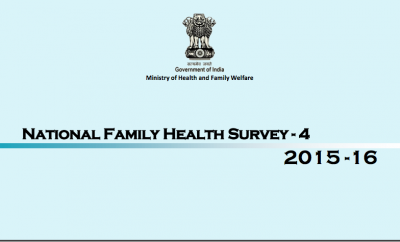National Family Health Survey-4 03/05/2019 – Posted in: Daily News
National Family Health Survey-4
For: Preliminary & Mains
News Flash
The National Family Health Survey 2015-16 (NFHS-4), the fourth in the NFHS series, provides information on population, health and nutrition for India and each State/Union territory. NFHS-4, for the first time, provides district-level estimates for many important indicators.
India continues to grapple with a high rate of undernutrition. According to the National Family Health Survey (NFHS)-4, India has unacceptably high levels of stunting, despite marginal improvement over the years.
In 2015-16, 38.4% of children below five years were stunted and 35.8% were underweight. India ranks 158 out of 195 countries on the human capital index.
Lack of investment in health and education leads to slower economic growth. The World Bank says, 1% loss in adult height due to childhood stunting is associated with a 1.4% loss in economic productivity.
Stunting also has lasting effects on future generations. Since 53.1% of women were anaemic in 2015-16, this will have lasting effects on their future pregnancies and children. The situation further worsens when infants are fed inadequate diets.
The aim of the National Nutrition Strategy of 2017 is to achieve a malnutrition-free India by 2022. The plan is to reduce stunting prevalence in children (0-3 years) by about three percentage points per year by 2022 from NFHS-4 levels, and achieve a one-third reduction in anaemia in children, adolescents and women of reproductive age.
This is an ambitious goal, especially given that the decadal decline in stunting from 48% in 2006 to 38.4% in 2016 is only one percentage point a year. This promise calls for serious alignment among line ministries, convergence of nutrition programmes, and stringent monitoring of the progress made in achieving these goals.
Variations across States and districts
- According to NFHS-4 data, India has more stunted children in rural areas as compared to urban areas, possibly due to the low socio-economic status of households in those areas.
- Almost double the prevalence of stunting is found in children born to mothers with no schooling as compared to mothers with 12 or more years of schooling.
- Stunting shows a steady decline with increase in household income.
- The inter-generational cycle of malnutrition is to be tackled with effective interventions for both mother (pre- and post-pregnancy) and child, to address the high burden of stunting.
- In terms of geographical regions, Bihar (48%), Uttar Pradesh (46%) and Jharkhand (45%) have very high rates of stunting, while States with the lowest rates include Kerala, and Goa (20%).
- While nutrition has improved across all States, inter-State variabilities remain extremely high. The most significant decline has been noted in Chhattisgarh (a 15 percentage point drop in the last decade).
- A study by the International Food Policy Research Institute shows that stunting prevalence varies across districts (12.4-65.1%), and almost 40% districts have stunting levels above 40%. U.P. tops the list, with six out of 10 districts having the highest rates of stunting.
Way Ahead
- Convergence of health and nutrition programmes right from pregnancy until the child reaches five years of age.
- India must adopt a multi-pronged approach in bringing about sociobehavioural change.
- Effective monitoring and implementation of programmes to address malnutrition.
For more Details: Click INDIA FACT SHEET
Source: The Hindu
You can follow us on LinkedIn and for more updates related to UPSC IAS Preparation, Like our Facebook Page and subscribe our Diligent IAS Youtube Channel

